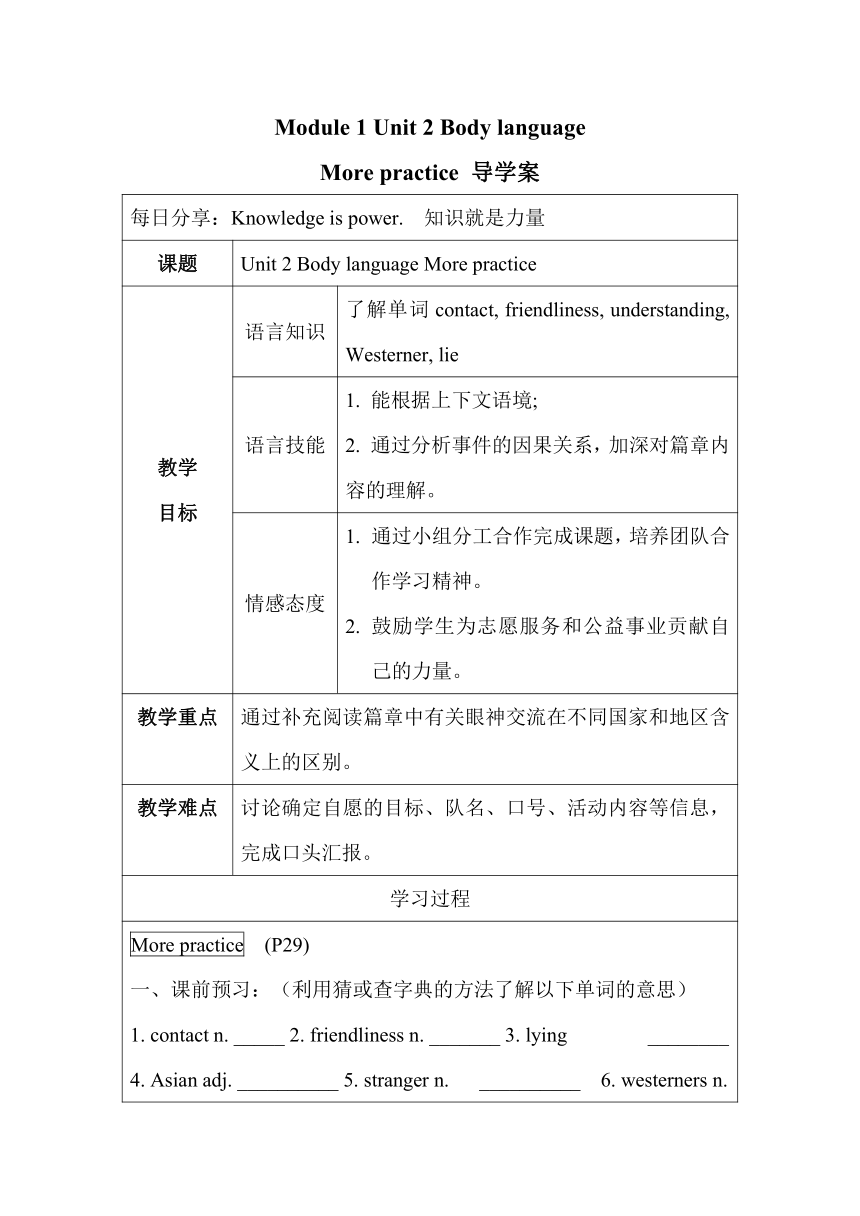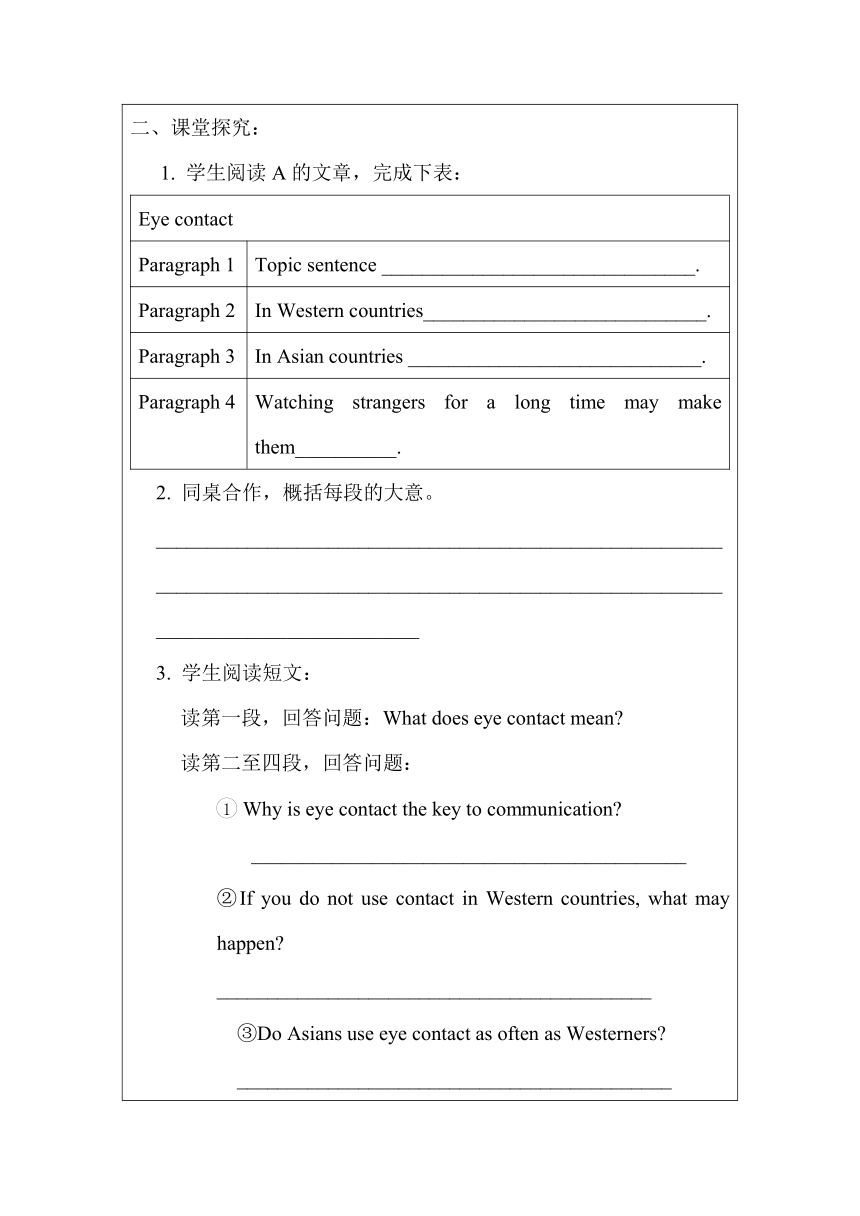广东省深圳市Module 1 Unit 2 Body language More practice 表格式学案
文档属性
| 名称 | 广东省深圳市Module 1 Unit 2 Body language More practice 表格式学案 |

|
|
| 格式 | zip | ||
| 文件大小 | 120.5KB | ||
| 资源类型 | 教案 | ||
| 版本资源 | 牛津深圳版 | ||
| 科目 | 英语 | ||
| 更新时间 | 2017-07-26 00:00:00 | ||
图片预览


文档简介
Module
1
Unit
2
Body
language
More
practice
导学案
每日分享:Knowledge
is
power.
知识就是力量
课题
Unit
2
Body
language
More
practice
教学目标
语言知识
了解单词contact,
friendliness,
understanding,
Westerner,
lie
语言技能
1.
能根据上下文语境;2.
通过分析事件的因果关系,加深对篇章内容的理解。
情感态度
通过小组分工合作完成课题,培养团队合作学习精神。鼓励学生为志愿服务和公益事业贡献自己的力量。
教学重点
通过补充阅读篇章中有关眼神交流在不同国家和地区含义上的区别。
教学难点
讨论确定自愿的目标、队名、口号、活动内容等信息,完成口头汇报。
学习过程
More
practice
(P29)一、课前预习:(利用猜或查字典的方法了解以下单词的意思)1.
contact
n.
_____
2.
friendliness
n.
_______
3.
lying
________4.
Asian
adj.
__________
5.
stranger
n.
__________
6.
westerners
n.
二、课堂探究:1.
学生阅读A的文章,完成下表:Eye
contactParagraph
1Topic
sentence
_______________________________.Paragraph
2In
Western
countries____________________________.Paragraph
3In
Asian
countries
_____________________________.Paragraph
4Watching
strangers
for
a
long
time
may
make
them__________.2.
同桌合作,概括每段的大意。__________________________________________________________________________________________________________________________________________3.
学生阅读短文:读第一段,回答问题:What
does
eye
contact
mean
读第二至四段,回答问题:Why
is
eye
contact
the
key
to
communication
___________________________________________②If
you
do
not
use
contact
in
Western
countries,
what
may
happen ___________________________________________③Do
Asians
use
eye
contact
as
often
as
Westerners ___________________________________________④What
kind
of
eye
contact
is
impolite
in
many
countries ___________________________________________
4.
学生四人一组,讨论B的问题,并口头汇报讨论结果。三、小结——阅读及写作方法指导:__________________________________________________________四、拓展练习:PPT演示同步练习册P27,学生读后快速找到答案。完成下列表格:Do’sDon’tsShake
hands
firmly.
Don’t
make
your
hand
feel
like______Often
look
the
interviewer_________Don’t
make
the
interviewer
feel_____Look
interested
and
______________Don’t
sit
in
a
____________Smile
and
nod
your
head.Don’t
___________across
your
chest.Make
sure
your
face
and
body
are___the
interviewer.Don’t
shake
your_________.(二)选择正确的词填空。1.
They
made
____
with
the
people
on
the
lonely
island
by
radio.(contact/communicate)2.
The
T-shirts
are
available
in
different
_______
of
colours.
(type/kinds)3.
He
has
lost
his
key
_____
the
car.
(of/to)4.
The
students
showed
great
____in
the
new
subject.
(interested/interest)5.
Looking
at
others
for
a
long
time
is
____
.(polite/impolite)6.
An
_____
person
might
look
down
while
listening
to
a
Western
speaker.
(Asia/Asian)7.
Eye
contact
can
show
feelings
such
as_____,
interest,
and
understanding.
(friends/friendliness)
8._______
too
much
eye
contact
is
not
polite.
(use/using)Culture
corner
PPT出示P30页插图导入阅读:让学生听并口头回答教师提出的问题。What
are
they
doing When
do
people
usually
use
this
way 学生阅读30页短文,回答问题。1.
What
do
people
in
India
and
some
other
Asian
countries
do
when
they
meet 2.
What
do
people
often
do
when
they
meet
in
many
countries 3.
Do
the
Brazilians
and
the
French
have
the
same
way
of
greeting Project
1.
教师问学生:Do
you
know
of
any
voluntary
groups
What
are
they
What
kind
of
people
do
voluntary
groups
help 2.
学生分组讨论P31A部分三个问题,制定拟组建的志愿队的目标,并简单陈理由。3.
教师讲解B部分中Top
tip
部分内容(有条件可以播放郭明义视频)。各组继续讨论本组志愿队的名称和口号。4.
各小组进一步讨论本组志愿队可能开展的各种活动,并完成C部分的表格。5.
各小组综合ABC三部分内容,写一份发言稿提纲,介绍本组拟组建的志愿队。然后派代表依照提纲发言,向全班介绍本组拟组建的志愿队。完成Self-assessment
板块关于单元学习情况的自我评价,并加强自己薄弱环节的学习。
总结反思:1.
通过本节课的学习我最大的收获:2.
感到自己有待加强的是:
1
Unit
2
Body
language
More
practice
导学案
每日分享:Knowledge
is
power.
知识就是力量
课题
Unit
2
Body
language
More
practice
教学目标
语言知识
了解单词contact,
friendliness,
understanding,
Westerner,
lie
语言技能
1.
能根据上下文语境;2.
通过分析事件的因果关系,加深对篇章内容的理解。
情感态度
通过小组分工合作完成课题,培养团队合作学习精神。鼓励学生为志愿服务和公益事业贡献自己的力量。
教学重点
通过补充阅读篇章中有关眼神交流在不同国家和地区含义上的区别。
教学难点
讨论确定自愿的目标、队名、口号、活动内容等信息,完成口头汇报。
学习过程
More
practice
(P29)一、课前预习:(利用猜或查字典的方法了解以下单词的意思)1.
contact
n.
_____
2.
friendliness
n.
_______
3.
lying
________4.
Asian
adj.
__________
5.
stranger
n.
__________
6.
westerners
n.
二、课堂探究:1.
学生阅读A的文章,完成下表:Eye
contactParagraph
1Topic
sentence
_______________________________.Paragraph
2In
Western
countries____________________________.Paragraph
3In
Asian
countries
_____________________________.Paragraph
4Watching
strangers
for
a
long
time
may
make
them__________.2.
同桌合作,概括每段的大意。__________________________________________________________________________________________________________________________________________3.
学生阅读短文:读第一段,回答问题:What
does
eye
contact
mean
读第二至四段,回答问题:Why
is
eye
contact
the
key
to
communication
___________________________________________②If
you
do
not
use
contact
in
Western
countries,
what
may
happen ___________________________________________③Do
Asians
use
eye
contact
as
often
as
Westerners ___________________________________________④What
kind
of
eye
contact
is
impolite
in
many
countries ___________________________________________
4.
学生四人一组,讨论B的问题,并口头汇报讨论结果。三、小结——阅读及写作方法指导:__________________________________________________________四、拓展练习:PPT演示同步练习册P27,学生读后快速找到答案。完成下列表格:Do’sDon’tsShake
hands
firmly.
Don’t
make
your
hand
feel
like______Often
look
the
interviewer_________Don’t
make
the
interviewer
feel_____Look
interested
and
______________Don’t
sit
in
a
____________Smile
and
nod
your
head.Don’t
___________across
your
chest.Make
sure
your
face
and
body
are___the
interviewer.Don’t
shake
your_________.(二)选择正确的词填空。1.
They
made
____
with
the
people
on
the
lonely
island
by
radio.(contact/communicate)2.
The
T-shirts
are
available
in
different
_______
of
colours.
(type/kinds)3.
He
has
lost
his
key
_____
the
car.
(of/to)4.
The
students
showed
great
____in
the
new
subject.
(interested/interest)5.
Looking
at
others
for
a
long
time
is
____
.(polite/impolite)6.
An
_____
person
might
look
down
while
listening
to
a
Western
speaker.
(Asia/Asian)7.
Eye
contact
can
show
feelings
such
as_____,
interest,
and
understanding.
(friends/friendliness)
8._______
too
much
eye
contact
is
not
polite.
(use/using)Culture
corner
PPT出示P30页插图导入阅读:让学生听并口头回答教师提出的问题。What
are
they
doing When
do
people
usually
use
this
way 学生阅读30页短文,回答问题。1.
What
do
people
in
India
and
some
other
Asian
countries
do
when
they
meet 2.
What
do
people
often
do
when
they
meet
in
many
countries 3.
Do
the
Brazilians
and
the
French
have
the
same
way
of
greeting Project
1.
教师问学生:Do
you
know
of
any
voluntary
groups
What
are
they
What
kind
of
people
do
voluntary
groups
help 2.
学生分组讨论P31A部分三个问题,制定拟组建的志愿队的目标,并简单陈理由。3.
教师讲解B部分中Top
tip
部分内容(有条件可以播放郭明义视频)。各组继续讨论本组志愿队的名称和口号。4.
各小组进一步讨论本组志愿队可能开展的各种活动,并完成C部分的表格。5.
各小组综合ABC三部分内容,写一份发言稿提纲,介绍本组拟组建的志愿队。然后派代表依照提纲发言,向全班介绍本组拟组建的志愿队。完成Self-assessment
板块关于单元学习情况的自我评价,并加强自己薄弱环节的学习。
总结反思:1.
通过本节课的学习我最大的收获:2.
感到自己有待加强的是:
同课章节目录
